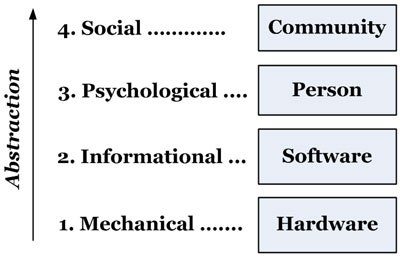 Even as HCI develops into a traditional academic discipline, computing has already moved on to add sociology to its list of paramours. Socio-technical systems use the social sciences in their design as HCI interfaces use psychology. STS is not part of HCI, nor is sociology part of psychology, because a society is more than the people in it; e.g. East and West Germany, with similar people, performed differently as communities, as do North and South Korea today. A society is not just a set of people. People who gather to view an event or customers shopping for bargains are an aggregate, not a community. They only become a community when they see themselves as one, i.e. the community level arises directly from personal level cognitions.
Even as HCI develops into a traditional academic discipline, computing has already moved on to add sociology to its list of paramours. Socio-technical systems use the social sciences in their design as HCI interfaces use psychology. STS is not part of HCI, nor is sociology part of psychology, because a society is more than the people in it; e.g. East and West Germany, with similar people, performed differently as communities, as do North and South Korea today. A society is not just a set of people. People who gather to view an event or customers shopping for bargains are an aggregate, not a community. They only become a community when they see themselves as one, i.e. the community level arises directly from personal level cognitions.
Social systems can have a physical base or a technical base, so a socio-physical system is people socializing by physical means. Face-to-face friendships cross seamlessly to Facebook because the social level persists across physical and electronic architecture bases. Whether electronically or physically mediated, a social system is always people interacting with people. Electronic communication may be “virtual” but the people involved are real.

Online communities work through people, who work through software that works through hardware. While sociology studies the social level alone, socio-technical design studies how social, human, information and hardware levels interact. A sociologist can no more design socio-technologies than a psychologist can design human-computer interfaces. STS and HCI need computer-sociologists and computer-psychologists. The complexity of modern computing arises from its discipline promiscuity (Figure 1.6).